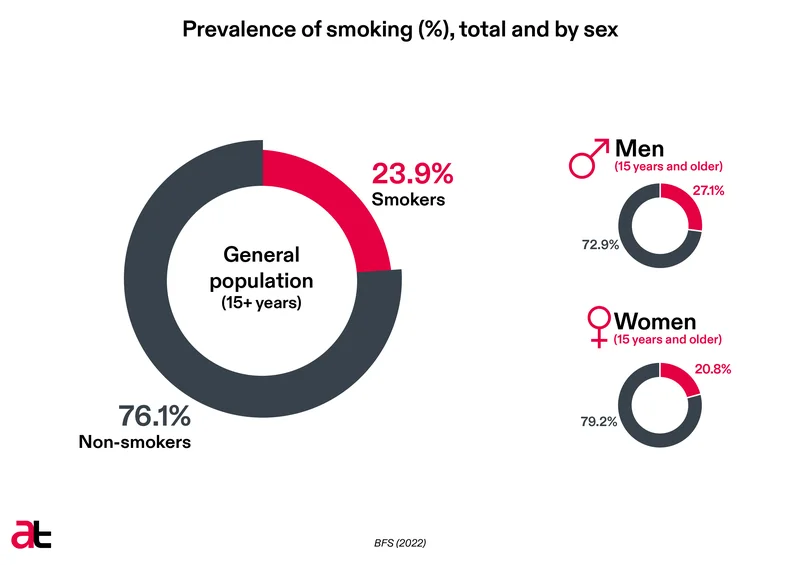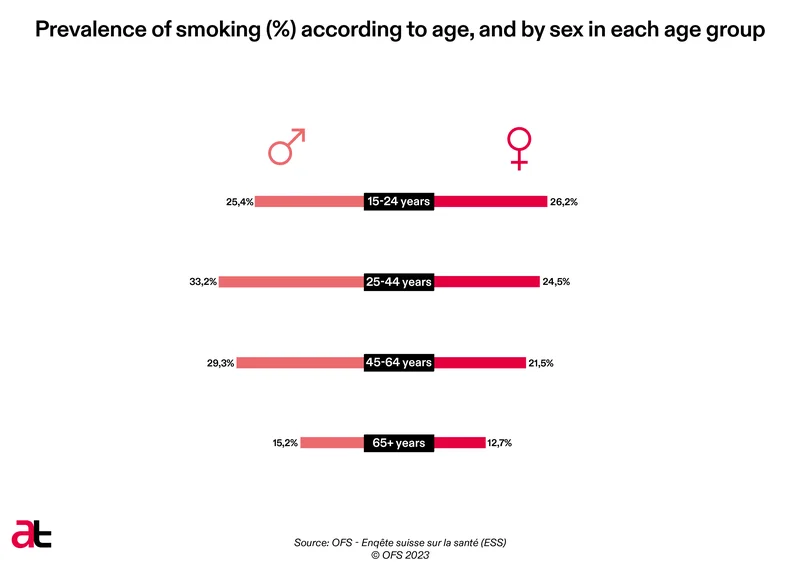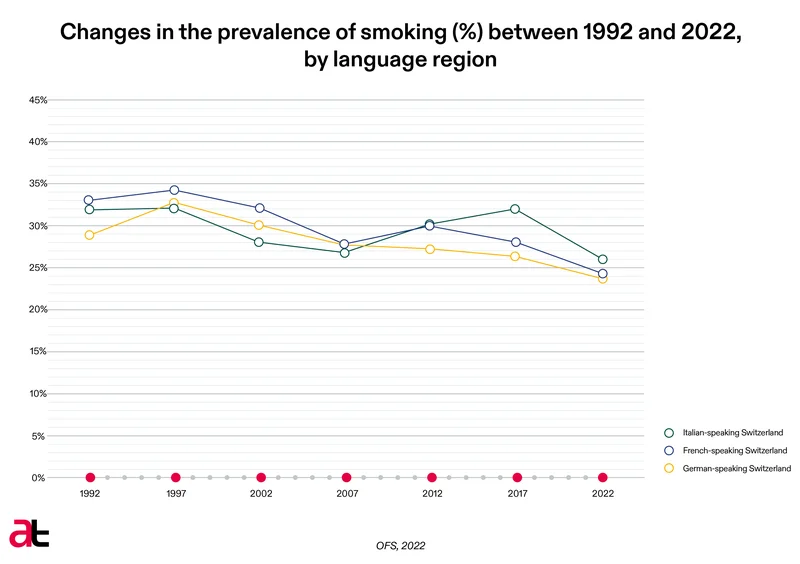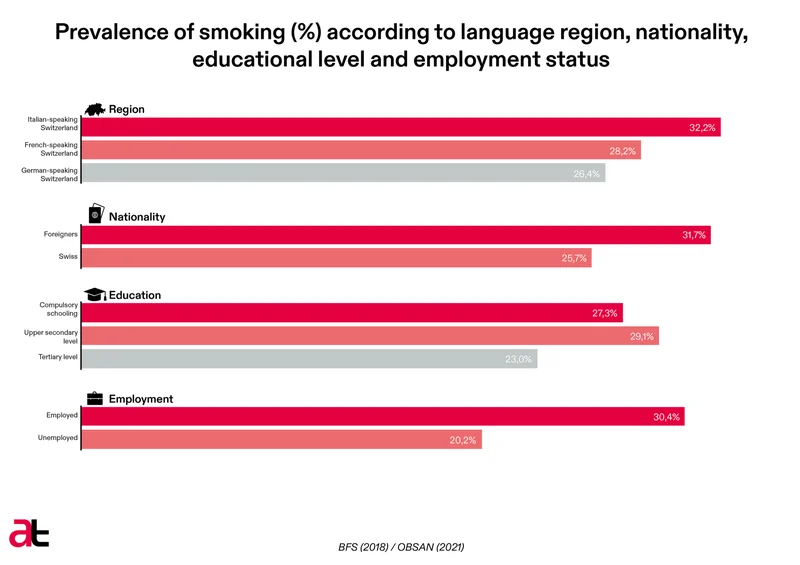The prevalence of smoking in the general population
- 23.9% of the population age 15 and over smokes.
- The groups with the highest rates of smoking are people under 45 years of age, men, and the lowest socioeconomic classes.
- More than two-thirds of smokers smoke daily, representing more than one person in five out of the total population 15 and over.
At the present time, the monitoring of smoking in Switzerland depends almost entirely on data collected for the Swiss health survey (ESS)[1]. These data, which are already limited by the relatively small number of questions relating to smoking in the ESS, are unfortunately in some ways subject to a systematic obsolescence, because they are collected only every five years, and the detailed estimates derived from them are available only a year or two after that. Other, older sources of data nonetheless allow for a fuller picture, which is presented in the following table.
Nearly a quarter of the population are smokers
In Switzerland, 23.9% of the population aged 15 and over smoke according to the most recent representative epidemiological data – data collected as part of the 2022 Swiss Health Survey (Figure A1A-1). However, this proportion varies relatively significantly across different population subgroups, particularly by age and gender, but also by other sociodemographic and economic characteristics.

Figure A1A-1 – Prevalence of smoking (%), in total and by sex, ESS 2022 (Sources OFS, 2023[2]).
Young people and men
People under age 45 and men are significantly more impacted by smoking than older adults and women.
For both men and women, among people under 45 (the age groups most affected by smoking), the proportion of female smokers varied in 2022 between 25.8% and 29.0%, depending on the age subcategories (Figure A1A-2).
In 2022, all ages combined, just over a fifth of women smoked – 20.8% – compared to 27.1% of men. Among the latter, smoking affected approximately one in three men aged 25 to 34 (32.9%) and 35 to 44 (33.4%) and more than one in four men aged 15 to 24 (25.4%) and 55 to 64 (26.9%). Among people aged 65 to 74, the proportion of smokers was around 20%, then decreased significantly. Among women, prevalences change significantly according to age, since it was in the 15 to 24 age group that the prevalence of smoking was highest, with 26.2%; this share then decreases slightly among women aged 25 to 34 (24.6%), 35 to 44 (24.3%) and 45 to 54 (20.1%), before starting to rise again among those aged 55 to 64 (22.9%). Rare enough to be highlighted, the 2022 ESS data suggest that currently the share of female smokers exceeds that of male smokers in the 15 to 24 age group.

Figure A1A-2 – Prevalence of smoking (%), by age and gender, ESS 2022 (Sources OFS, 2023[2]).
Regional and socioeconomic disparities
Slight variations in the extent of smoking are also observed among linguistic regions (Figure A1A-3a). In 2022, Italian-speaking Switzerland (26.0% of female smokers) had slightly more female smokers than German-speaking Switzerland (23.7%) and French-speaking Switzerland (24.3%). More significant differences are observed among people over 25 years of age according to the level of education: those who had completed at most compulsory education (25.2%) or secondary II education (26.9%) showed significantly higher smoking rates than those who had completed higher vocational education or university studies (20.0%).

Figure A1A-3a – Prevalence of smoking (%) by linguistic region and level of education and activity, ESS 2022 (Source OFS, 2023[3]).
The 2017 ESS data (Figure A1A-3b) further revealed that differences also exist based on nationality and professional status (Note: results not yet available based on the 2022 ESS data). In 2017, while the proportion of female smokers reached 25.7% among the Swiss, it was 31.7% in the foreign population (statistically significant difference; OBSAN, 2021[4]). Being considered active (working for pay) was also associated with a higher proportion of female smokers (30.4% versus 20.2% for people categorised as inactive; MONAM[5]).

Figure A1A-3b – Prevalence of smoking (%) by nationality and activity, ESS 2017 (Sources OFS, 2018[6] and *OBSAN, 2021[7]).
In-depth analyses using the data from the Swiss health survey from 2012 had already uncovered a significant link between tobacco use and being young, male, having a lower educational level, and being actively employed (Thrul, 2014[8]).
A very large number of daily smokers
Daily tobacco use clearly exceeds occasional use. Based on ESS data from 2017 (Note: results not yet available based on ESS data from 2022), more than two-thirds of female smokers smoke every day (OBSAN, 2021[9]), or nearly one in five people in the entire population aged 15 and over (19.1%). Among men, this share reached 21.5% (for a total of 31.0% of smokers) and among women 16.8% (for a total of 23.3% of smokers), which represents more than one in six women aged 15 and over in Switzerland.
It should be noted that analyses of the data from the CoRolAR study, which were performed for the Monitorage Suisse des addictions, highlighted the fact that the proportion of smokers was clearly higher among those with less education, especially for men (Gmel et al., 2017[10]); while 27.0% of men having completed only the nationally required level of education smoked daily, only 10.2% of men with a university or technical college education were doing this.
[1] https://www.bfs.admin.ch/bfs/de/home/statistiken/gesundheit/erhebungen/sgb.html; accessed on 16.11.2023.
[2] https://www.bfs.admin.ch/bfs/de/home/statistiken/gesundheit/determinanten/tabak.html; accessed on 16.11.2023.
[3] https://www.bfs.admin.ch/bfs/de/home/statistiken/gesundheit/determinanten/tabak.assetdetail.6466022.html; accessed on 16.11.2023.
[4] https://ind.obsan.admin.ch/indicator/monam/tabakkonsum-alter-15; accessed on 9.12.2021.
[5] https://ind.obsan.admin.ch/indicator/monam/tabakkonsum-alter-15; accessed on 9.12.2021.
[6] https://www.bfs.admin.ch/bfs/de/home/statistiken/gesundheit/determinanten/tabak.assetdetail.6466013.html; accessed on 9.12.2021.
[7] https://ind.obsan.admin.ch/indicator/monam/tabakkonsum-alter-15; accessed on 9.12.2021.
[8] Thrul, Johannes (2014): Soziodemografische Einflussfaktoren auf den Substanzkonsum der Schweizer Bevölkerung – Ergebnisse der Schweizerischen Gesundheitsbefragung 2012. Sucht Schweiz. Lausanne. Download.
[9] https://ind.obsan.admin.ch/fr/indicator/monam/tabagisme-age-15; accessed on 9.12.2021.
[10] Gmel, H.; Kuendig, Hervé; Notari, Luca; Gmel, C. (2017): Suchtmonitoring Schweiz
Konsum von Alkohol, Tabak und illegalen Drogen in der Schweiz im Jahr 2016. Sucht Schweiz. Lausanne; Download; accessed on 9.12.2021.
AT Switzerland, July 2025